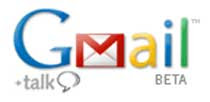
My initial experiences in a business professional role with Google technology beyond the search engine started with Gmail. Gmail started as Google's free web mail service and has been incorporated into its Google Apps suite, although you can still sign up for a free email account alone if you want. It set the standard for near-unlimited mailbox space among its competitors, and its easy to use interface, many intuitive features and powerful search capabilities made it a viral hit for many web users. In fact, Gmail set the pace for all other popular mail providers such as AOL, Hotmail and Yahoo to start AJAX-ifying their own interfaces in order to produce better user experiences.
One cool feature I liked about GMail was the ability to insert periods (.) anywhere within your email address to create separate "virtual" email addresses. Thus, for business purposes, I gave my email address as nissan (dot) dookeran (at) gmail (dot) com, but for mailing list subscriptions or sites which required me to sign up with an email address I would use nissandookeran (at) gmail (dot) com. This way I could easily use Gmail's filters to tag the business emails with their own label and prioritise them over less important emails.
Using labels rather than creating folders as destinations for filtered emails is definitely a different, but still very useful, approach to sorting volumes of emails. With 3GB and counting of available email space, there's definitely need for these types of innovations to keep things manageable.
Contact management is also quite simple with Gmail. Basically any email to which a "Reply-To" link is clicked automatically adds that email address to your contacts database. Now this initially was quite useful to me for creating quick coworker, client and mailing list emails. Eventually though the contacts database became a bit polluted, as one-time reply to addresses, such as mailing list subscription and unsubscription addresses, became automatically added into My Contacts as well. Google has recently produced a solution to this issue, deciding to auto-add addresses to a "Suggested Contacts" list from which a contact can then be moved into the My Contacts section manually, with the address being automatically added to your contacts database if you've sent email to the "suggested contact" five or more times.
Spam is virtually non-existent, as Gmail's powerful spam-filtering capabilities have in my experience only allowed at most one or two emails per month through their strong protective barrier. Compared to the hundreds of email per month I receive, and with hundreds of spam messages being caught automatically, this is quite good enough for me compared to my past horrendous experiences with Microsoft Outlook's Junk Mail feature. Google's recent acquisition of Postini has only served to strengthen its ability to produce higher grades of security in its Google Apps products.
Two useful sites I have found for maximising Gmail and becoming a power user are the official Gmail blog and the Gmail Google Group. Occasional checks on the Gmail blog reveal the new and upcoming features and by using the Gmail Google Group any technical difficulties not explained by FAQs or the help itself can often be answered quite easily.
One thing that Gmail still misses though is an offline/desktop client. The Google Gears technology makes one likely to be in the making, and the rumours are already there about it, but to date there hasn't been any beta produced (or even confirmation a beta version is in the works). Most folks would have no problem with web-based email given the superb nature of the Gmail interface, but there are two types of users who still require this. The die-hard Outlook users among us, and those who are on severely limited Internet connections such as dial-up and need to make web pages load as fast as possible as often as possible.
In fairness, the second type of user does have the option of disabling the AJAX features of Gmail and using a Basic HTML view, but this limits the user experience tremendously and being one of the second type, I found this option not very appealing.
I personally have chosen to move back to Microsoft Outlook as my email client of choice until my Internet scenario changes, but thankfully I've found the experience quite useful at learning just how much Gmail's creators have catered for a varying audience. Setting up Outlook to receive my Gmail content was quite simple as Gmail provides IMAP/SMTP settings or POP3/SMTP settings to allow receiving and sending emails through any mail client.
Google even surprised me when I saw that email that is sent from Outlook via my Gmail account gets logged into my Sent Items on my Gmail web interface, removing any concerns I had about future synchronisation problems.
While this is by no means an exhaustive list of features, and I have purposefully left out mentioning features such as Calendar synchronisation with Outlook and Chat integration in Gmail's web interface for future posts where I write specifically on GCal and Google Talk, I hope that this post is sufficiently enticing and filled with enough links to get the non-Gmail user (if they still exist) trying out this excellent free tool, and that it will also get current Gmail users experimenting and becoming power users in their own right.

No comments:
Post a Comment